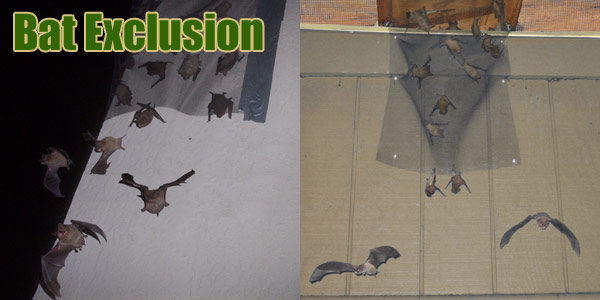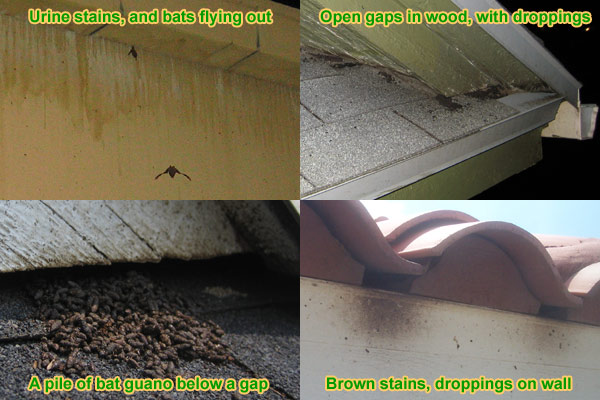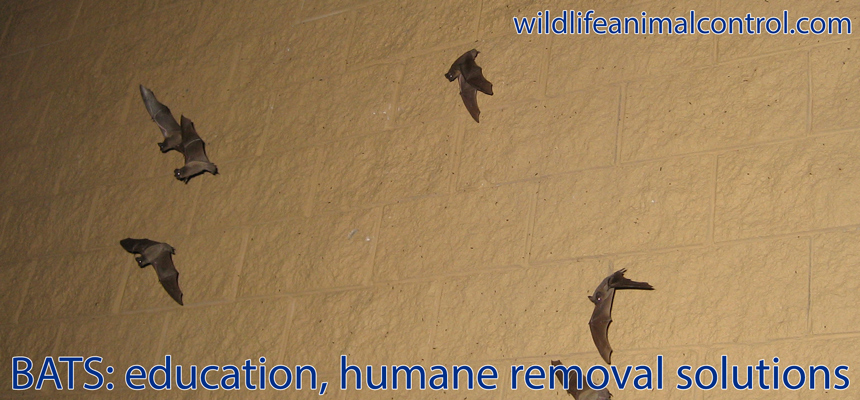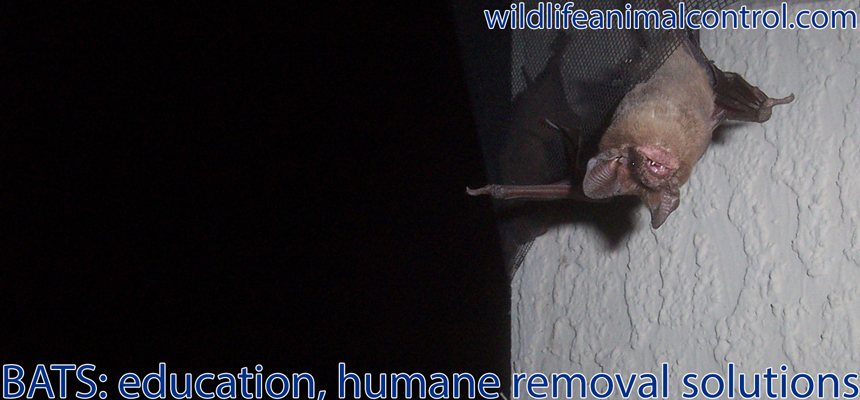- info@wildlifeanimalcontrol.com
Call us for help in your town
Wildlife Control Education
How to Get Rid of Bats in the Attic

We perform professional bat control in over 1700 USA locations - serving the whole USA. It is my goal to educate the public about bats and other wildlife, and
provide tips for safe, effective, and responsible wildlife removal.
Summary of Step-By-Step Instructions:
1) Observe your house at dusk to see exactly where the bats are flying out. Inspect inside the attic as well, and identify which species of bat you have.
2) Get on a ladder and carefully inspect the house for entry holes - bats can enter gaps as small as 3/8"
3) Seal all open gaps NOT currently used by bats. Seal with caulk or high-density polyurethane foam.
4) Install one-way exclusion devices on the entry/exit areas. This can be netting, funnels, or other devices, depending on the type of bat and architecture.
5) Wait at least 3 days, and observe the building to see if any bats are still able to enter or exit.
6) Once all bats are gone, remove the exclusion devices and seal the holes.
7) Remove the guano from the attic and disinfect against mold, airborne pathogens, and odor.
Need bat removal in your hometown? We service over 500 USA locations! Click here to hire us in your town and check prices - updated for year 2020.
Bats are the only mammals that are capable of flight. Bats can be described as small, black or dark brown creatures that have skin flaps that attach to their wrists and stretch out to their ankles. They primarily eat insects, but some species will also eat fruits and vegetables. Usually bats do not bother anyone and are great to have around because they keep harmful bugs like spiders, mosquitoes and flies out of your house. However, if you find bats living where they shouldn't be living such as in your attic, shed or garage you probably want them out.
How to Get Rid of Bats - Bats are only considered pests by some because they make a lot of noise and their droppings can create a really big mess. Bats are primarily active during the night, but if they are nesting in your home or near your home you can hear the chirping all the time which is unsettling and drive some people insane. A colony can leave behind an immense amount of droppings which can sometimes carry diseases that can infect people. The droppings also tend to attract cockroaches. Bats will also chew and claw their way into a place where they can nest creating holes in your walls. Some bats have rabies and can pass this to your pet that gets curious and sticks its head into their home.

If you want to get rid of bats that are in or around your house, try one or all of these tricks to get rid of them for good:
- The first thing that you need to do is call your local animal control office or call the wildlife fish and game office and see what the laws are concerning the removal of bats. Bats are endangered in some states and you might not be able to move them or you will have to wait for a professional to come and remove them.
- Also, you must wait until it is a good time to get rid of them. For example, you cannot get rid of bats in the winter because they are hibernating and will all die if you put them out in the winter. Not only is this inhumane, it is illegal.
- You need to determine where the bats are getting in. The easiest way to find this location is by looking for their dropping and the shells of dead insects. When you find the droppings and food, you will find the nest right above it.
- After you have located the entryway into the nest you will have to wait until they leave for the night and put up a temporary block of wire mesh or durable fabrics. The plug needs to be temporary because not all the bats will leave the first night. On the next night open the hole and let the stragglers out. You should repeat the process for a week to make sure that all of them are out.
- After you have gotten rid of the nest, you must clean and decontaminate the area with all of the droppings so that they are not attracted back to your home. After this is done, you can seal up the wall and you should be rid of your bat infestation.
- If the bats are still sticking around the outside of your home you can stick mothball sacks in the trees and get one of the many available chemical repellents to spray on your trees or in your barn. Bats have a very strong sense of smell and will stay away from places that they consider stinky.
If you can live with the bats, it is much better because they do a lot of good things for the ecosystem around your house. They are also a vulnerable species and could die if you move them. However, if you simply cannot live with them, try some of these effective tips and your bat problems will be gone in no time.
More in-detail how-to bat removal articles:
Information about bat trapping - analysis and methods
for how to trap.
Information about how to kill a bat - with fumigants or poison.
Information about how to keep bats away - prevention techniques.
Information about how to catch a bat - remove one stuck in the house.
Information about bat repellent - analysis of types and effectiveness.

Bat Information & Facts
Bat Appearance: The simplest description of a bat is that it strongly resembles a flying mouse. This is a general description, as many bats have unique characteristics, especially on the face and head distinguishing them from other bats subspecies. Bats are mammals with bodies anywhere from one inch to twelve inches with wing spans of equal variability. All bats have wings composed of a thin membrane of skin. Most of these animals have large ears, an attribute which helps with the use of echolocation. Since a system of sonar is used for primary location purposes, the visual sight of a bat is relatively poor. Bats can see ultraviolet light and are not blind as some people suspect. A keen sense of smell makes up for any lack of visual adeptness. Bat teeth are very tiny and very sharp. These small teeth are used for puncturing insect skin and vegetation.Bat Habitat and Behavior: The most common bats in the United States are the little brown bat, the big brown bat, and the Mexican freetail bat. All three of these subspecies are echolocation bats, or bats that use sound vibrations to discern the location of objects. These bats have a variety of tastes when it comes to habitat, but a primary decision in location has to do with the need to roost. Bats need areas protected from light, be they attics, caves, hollow trees, or a thick canopy of leaves. This species hibernates and will fly for hundreds of miles to locate a place of seclusion and safety. These two factors are important in the selection of a roost area.
Bats with echolocation are using a complex system of sound vibrations which allow them to determine distance, speed, and even identification of prey. Nocturnal, bats leave the roost at dusk. The hours of twilight are when insects are most active, and invertebrates are a major food source for bats. Rain droplets confuse their echolocation system, rendering them unable to locate small prey. For this reason, bats rarely fly in the rain. Recent studies have shown that bats use the magnetic poles of the planet to find their way back to the colony over long distances. The receptors in a bat's brain sensitive to the magnetic pull of the poles can be damaged and could result in the bat being unable to find its way back to the roost. Other studies have found a bat with injured receptors will eventually compensate and, for reasons yet unknown, manage to make it back to the roost.

Roosting bats will often create colonies entirely of females with the sole purpose of birthing young. Only one offspring is born to an adult female, though the bat may have up to three babies in a year. Baby bats will nurse until their wings are developed enough for flight. Depending on the subspecies, weaning can take place around four months of age.
Bat Diet: Once a bat is weaned, it is completely responsible for its own food acquisition. The little brown bat, the big brown bat, and the Mexican freetail bat are all omnivorous creatures, relying on a diet of mostly insects and fruit. Other subspecies will consume nectar, birds, small amphibians, and blood. A bat can eat up to a third of its body weight in insects per feeding. Hydration is maintained by flying over bodies of water and skimming drops off the surface.
Bat Nuisance Concerns: Bats in nature pose no immediate threat for people, but bats living in close proximity can be considered nuisances. Attics are alluring areas for bats to form roosts. The attic is warm, protected, dark, and relatively quiet. Bats in attics are most often female birthing colonies. They can number in the hundreds and can create significant damage due to their caustic waste. Feces, known as guano, can be particularly dangerous and harbors a large potential for disease.
Bat Diseases: Zoonotic diseases are a big concern due to the widespread coverage of bat populations. Severe diseases humans can catch from bats include rabies, SARS, Henipavirus, and ebola virus. Many of these diseases do not affect the bat but can prove deadly to a person. Most bat bites are tiny enough not to be felt, so a person who awakens to a dead bat nearby should seek immediate medical attention.

This site is intended to provide bat education and information, so that you can make an informed decision if you need to deal with a bat problem. This site provides many bat control articles and strategies, if you wish to attempt to solve the problem yourself. If you are unable to do so, which is likely with many cases of bat removal, please go to the home page and click the USA map, where I have wildlife removal experts listed in over 500 cites and towns, who can properly help you with your nuisance bat.
Read more articles about bats written based on my years of professional experience. Learn what you should do with a bat after you catch it and what you should do if you are bitten by a bat. Find out how many bugs bats eat each night, the effectiveness of poison when dealing with bats, what to do about a bat in the chimney, and how to get bats out of the attic. Read to learn if a bat in the attic will have a nest of babies, how to get bats out of a barrel tile roof, and everything you need to know about Bat bug infestations and the Bat calendar. Learn what materials are best for excluding bats and how to clean bat feces out of your attic. Read my best advice for using one-way exclusion funnels to remove bats, and if a bat house will prevent bats from entering your home. Learn about histoplasmosis, if the city or county animal services will help wiht a bat issue, and if bats really avoid light. Find out about bat mating habits, maternity colonies, and if bats migrate.
Read about what property modifications will help keep bat colonies down, how do bats drink water, and if bat feces are dangerous to touch or breathes. Learn about White Nose Syndrome, the summer maternity season, and if bats can walk on the ground. I can show you the kind of damage bats can cause in an attic, and how to keep bats out of a barn. Learn how to remove a dead bat and what wildlife rehabilitators do with bats. Read my thoughts on if you should hire a pro or remove bats yourself, and if you should ever poison a bat. Learn if a pest control company will remove a bat, and what kinds of noises and sounds bats make.

















